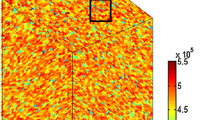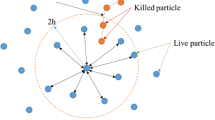Abstract
A novel numerical model in the framework of General Particle Dynamics is proposed to simulate the coupling effects of the vertical stress and the internal hydraulic pressure on the stress field around the tips of the flaw as well as the propagation and coalescence of cracks. In this proposed method, interaction among discrete particles is formulated using the virtual-bond method. Fractures of the virtual bonds among particles are determined by the Hoek–Brown damage evolution law of rocks. The fractured virtual bonds can only bear the compressive and frictional behaviors between two particles, while the unbroken virtual bonds can bear the tensile, shear and compressive behaviors. Furthermore, a novel generated particle method is proposed to simulate the flow of fissure water. The numerical results show that the water pressure plays a key role in the stress fields around flaw tips as well as the propagation paths and the coalescence pattern of wing and secondary cracks.






















Similar content being viewed by others
Abbreviations
- D :
-
A disturbance coefficient
- E :
-
Young’s modulus
- f :
-
Interaction factor
- \(\rho\) :
-
Real-time mass density of particles
- \(\rho_{0}\) :
-
The initial density
- \(x^{\alpha }\) :
-
The spatial coordinate
- \(v^{\alpha }\) :
-
Velocity vector
- \(\sigma^{\alpha \beta }\) :
-
Cauchy stress tensor
- \(\omega\) :
-
Homogeneous index
- D m :
-
Damage factor
- G :
-
Shear modulus
- D a :
-
Particles with damaged bonds
- h :
-
Smoothing length
- v :
-
Poisson ratio
- k :
-
The modulus of volume elasticity
- N f :
-
Damage coefficient
- \(\rho_{\text{w}}\) :
-
Water particle density
- \(\rho_{\text{s}}\) :
-
Solid particle density
References
Beiseel SR, Gerlach CA, Johnson GR (2006) Hypervelocity impact computations with finite elements and meshfree particles. Int J Impact Eng 33(1–12):80–90
Bi J, Zhou XP, Xu XM (2016a) Numerical simulation of failure process of rock-like materials subjected to impact loads. Int J Geomech 04016073:1–13
Bi J, Zhou XP, Qian QH (2016b) The 3D numerical simulation for the propagation process of multiple pre-existing flaws in rock-like materials subjected to biaxial compressive loads. Rock Mech Rock Eng 49(5):1611–1627
Bobet A (1997) Fracture coalescence in rock materials: experimental observations and numerical predictions. Sc.D. thesis Massachusetts Institute of Technology
Bobet A, Einstein HH (1998) Fracture coalescence in rock-type materials under uniaxial and biaxial compression. Int J Rock Mech Min Sci 35(7):863–888
Bouchard PO, Baya F, Chastela Y, Tovena I (2000) Crack propagation modelling using an advanced remeshing technique. Comput Methods Appl Mech Eng 189:723–742
Chakraborty S, Shaw A (2013) A pseudo-spring based fracture model for SPH simulation of impact dynamics. Int J Impact Eng 58:84–95
Chen HM, Zhao ZY, Choo LQ, Sun JP (2016) Rock cavern stability analysis under different hydro-geological conditions using the coupled hydro-mechanical model. Rock Mech Rock Eng 49:555–572
Das R, Zhang Y, Schaubs P, Cleary PW (2014) Modelling rock fracturing caused by magma intrusion using the smoothed particle hydrodynamics method. Comput Geosci 18:927–947
Deb D, Pramanik R (2013) Failure process of brittle rock using smoothed particle hydrodynamics. J Eng Mech 139(11):1551–1565
Gonçalves da Silva B, Einstein HH (2012) Study of stress and strain fields around a flaw tip in rock. In: Proceedings of the 46th U.S. Rock Mechanics and Geomechanics Symposium. Chicago, pp 2074–2089
Gonçalves da Silva B, Einstein HH (2013) Modeling of crack initiation, propagation and coalescence in rocks. Int J Fract 182(2):167–186
Hallquist JO (1998) Ls-dyna theortical manual. Livermore Software Technology Corporation, Waverley Way, Livermore
Hoek E (1983) Strength of jointed rock masses. Geotechnique 33:187–223
Hoek E (1990) Estimating Mohr–Coulomb friction and cohesion values from the Hoek–Brown failure criterion. Int J Rock Mech Min Sci 27:227–229
Hoek E, Brown ET (1980) Empirical strength criterion for rock masses. ASCE J Geotech Geoenviron Eng 106(GT9):1013–1036
Hoek E, Brown ET (1997) Practical estimate the rock mass strength. Int J Rock Mech Min Sci 34:1165–1186
Hou ZM, Zhou L, Kracke T (2013) Modelling of seismic events induced by reservoir stimulation in an enhanced geothermal system and a suggestion to reduce the deformation energy release. In: Rock dynamics and applications—state of the art. Taylor and Francis Group. London, United Kingdom, pp 161–175
Lee H, Jeon S (2011) An experimental and numerical study of fracture coalescence in pre-cracked specimens under uniaxial compression. Int J Solids Struct 48:979–999
Liang ZZ, Xing H, Wang SY, Williams DJ, Tang CA (2012) A three-dimensional numerical investigation of the fracture of rock specimens containing a pre-existing surface flaw. Comput Geotech 45:19–33
Libersky LD, Petschek AG (1991) Smoothed particle hydrodynamics with strength of materials. In: Trease H, Friits J, Crowley W (eds) Proceedings of the next free Lagrange conference, vol 395. Springer, New York, pp 248–257
Libersky LD, Petschek AG, Carney TC, Hipp JR, Allahdadi FA (1993) High strain Lagrangian hydrodynamics: a three dimensional SPH code for dynamic material response. J Comput Phys 109:67–75
Liu ZL, Menouillard T, Belytschko T (2011) An XFEM/Spectral element method for dynamic crack propagation. Int J Fract 169(2):183–198
Ma GW, Wang QS, Yi XW, Wang XJ (2014) A modified SPH method for dynamic failure simulation of heterogeneous material. Math Prob Eng 2014(1):1–14
Mehra V, Chaturvedi S (2006) High velocity impact of metal sphere on thin metallic plates: a comparative smooth particle hydrodynamics study. J Comput Phys 212(1):318–337
Miller JT (2008) Crack coalescence in granite. S.M. thesis Massachusetts Institute of Technology
Monaghan JJ (1988) An introduction to SPH. Comput Phys Commun 48(1):89–96
Monaghan JJ, Gingold RA (1983) Shock simulation by the particle method SPH. J Comput Phys 52:374–389
Monaghan JJ, Lattanzio JC (1985) A refined particle method for astrophysical problems. Astron Astrophys 149(1):135–143
Morgan SP, Johnson CA, Einstein HH (2013) Cracking processes in Barre granite: fracture process zones and crack coalescence. Int J Fract 180:177–204
Paluszny A, Matthai SK (2009) Numerical modeling of discrete multi-crack growth applied to pattern formation in geological brittle media. Int J Solids Struct 46:3383–3397
Park CH, Bobet A (2009) A Crack coalescence in specimens with open and closed flaws: a comparison. Int J Rock Mech Min Sci 46(5):819–829
Potyondy DO, Cundall PA (2004) A bonded-particle model for rock. Int J Rock Mech Min Sci 41:1329–1364
Quercia G, Chan D, Luke K (2016) Weibull statistics applied to tensile testing for oil well cement compositions. J Petrol Sci Eng. doi:10.1016/j.petrol.2016.07.012
Reyes O (1991) experimental study and analytical modeling of compressive fracture in Brittle materials. Ph.D. thesis Massachusetts Institute of Technology
Sagong M, Bobet A (2002) Coalescence of multiple flaws in a rock-model material in uniaxial compression. Int J Rock Mech Min Sci 39(2):229–241
Shaw A, Reid SR (2009a) Applications of SPH with the acceleration correction algorithm in structural impact computations. Curr Sci 97(8):1177–1186
Shaw A, Reid SR (2009b) Heuristic acceleration correction algorithm for use in SPH computations in impact mechanics. Comput Method Appl Mech Eng 198:3962–3974
Shen B, Stephansson O, Einstein HH, Ghahreman B (1995) Coalescence of fractures under shear stresses experiments. J Geophys Res 100(B4):5975–5990
Silva BG, Einstein HH (2014) Finite Element study of fracture initiation in flaws subject to internal fluid pressure and vertical stress. Int J Solids Struct 51:4122–4136
Tran LB, Udaykumar HS (2004) A particle-level set-base sharp interface Cartesian grid method for impact, penetration and void collapse. J Comput Phys 193:469–510
Vasarhelyi B, Bobet A (2000) Modeling of crack initiation, propagation and coalescence in uniaxial compression. Rock Mech Rock Eng 33(2):119–139
Wang J, Chan D (2014) Frictional contact algorithms in SPH for the simulation of soil–structure interaction. Int J Numer Anal Met 38:747–770
Wangen M (2013) Finite element modeling of hydraulic fracturing in 3D. Comput Geosci 17(4):647–659
Weibull W (1951) A statistical distribution function of wide applicability. Int J Appl Mech 18:293–297
Wong NY (2008) Crack coalescence in molded gypsum and Carrara marble. Ph.D. thesis Massachusetts Institute of Technology
Wong RHC, Chau KT (1998) Crack coalescence in a rock-like material containing two cracks. Int J Rock Mech Min Sci 35(2):147–164
Wong LNY, Einstein HH (2009a) Crack coalescence in molded gypsum and Carrara marble: part 1. Macroscopic observations and interpretation. Rock Mech Rock Eng 42(3):475–511
Wong LNY, Einstein HH (2009b) Systematic evaluation of cracking behavior in specimens containing single flaws under uniaxial compression. Int J Rock Mech Min Sci 46(2):239–249
Wong RHC, Chau KT, Tang CA, Lin P (2001) Analysis of crack coalescence in rock-like materials containing three flaws—part I: experimental approach. Int J Rock Mech Min Sci 38(7):909–924
Wu ZJ, Wong LNY (2012) Frictional crack initiation and propagation analysis using the numerical manifold method. Comput Geotech 39:38–53
Yang SQ, Yang DS, Jing HW, Li YH, Wang SY (2012) An experimental study of the fracture coalescence behaviour of brittle sandstone specimens containing three fissures. Rock Mech Rock Eng 45(4):563–582
Yarushina VM, Bercovici D, Oristaglio ML (2013) Rock deformation models and fluid leak-off in hydraulic fracturing. Geophys J Int 194(3):1514–1526
Yoon J (2007) Application of experimental design and optimization to PFC model calibration in uniaxial compression simulation. Int J Rock Mech Min Sci 44:871–889
Zhang HH, Li LX, An XM, Ma GW (2010) Numerical analysis of 2-D crack propagation problems using the numerical manifold method. Eng Anal Bound Elem 34:41–50
Zhou XP, Bi J (2016) 3D numerical study on the growth and coalescence of pre-existing flaws in rocklike materials subjected to uniaxial compression. Int J Geomech 16(4):04015096-1–04015096-21
Zhou XP, Yang HQ (2012) Multiscale numerical modeling of propagation and coalescence of multiple cracks in rock masses. Int J Rock Mech Min Sci 55:15–27
Zhou XP, Bi J, Qian QH (2015) Numerical simulation of crack growth and coalescence in rock-like materials containing multiple pre-existing flaws. Rock Mech Rock Eng 48(3):1097–1114
Acknowledgements
This work was supported by Project (No. 0903005203452) supported by the Fundamental Research Funds for the Central Universities, Project 973 (Grant No. 2014CB046903), the National Natural Science Foundation of China (Nos. 51325903 and 51279218), The general project of Chongqing Foundation (cstc2014-jcyjA30016).
Author information
Authors and Affiliations
Corresponding author
Rights and permissions
About this article
Cite this article
Bi, J., Zhou, X.P. A Novel Numerical Algorithm for Simulation of Initiation, Propagation and Coalescence of Flaws Subject to Internal Fluid Pressure and Vertical Stress in the Framework of General Particle Dynamics. Rock Mech Rock Eng 50, 1833–1849 (2017). https://doi.org/10.1007/s00603-017-1204-4
Received:
Accepted:
Published:
Issue Date:
DOI: https://doi.org/10.1007/s00603-017-1204-4




